Organisational Behaviour: Workforce Diversity and Management Theories
VerifiedAdded on 2023/06/12
|8
|2209
|285
Essay
AI Summary
This essay explores organisational behaviour, focusing on how workers influence organisations and vice versa. It examines factors such as corporate culture, leadership styles, and workplace characteristics that motivate employees. The study analyses the impact of cultural, ethical, and social issues on organisational behaviour, emphasising the importance of managing workforce diversity. The essay also discusses recent developments in organisational behaviour, including the adoption of diversity practices and the promotion of equality and self-governance. It concludes by highlighting the significance of motivation, attitude, and task distribution in achieving organisational goals and maximising profit, advocating for continuous counselling and training to foster a positive and productive work environment. Desklib provides access to similar solved assignments and past papers for students.
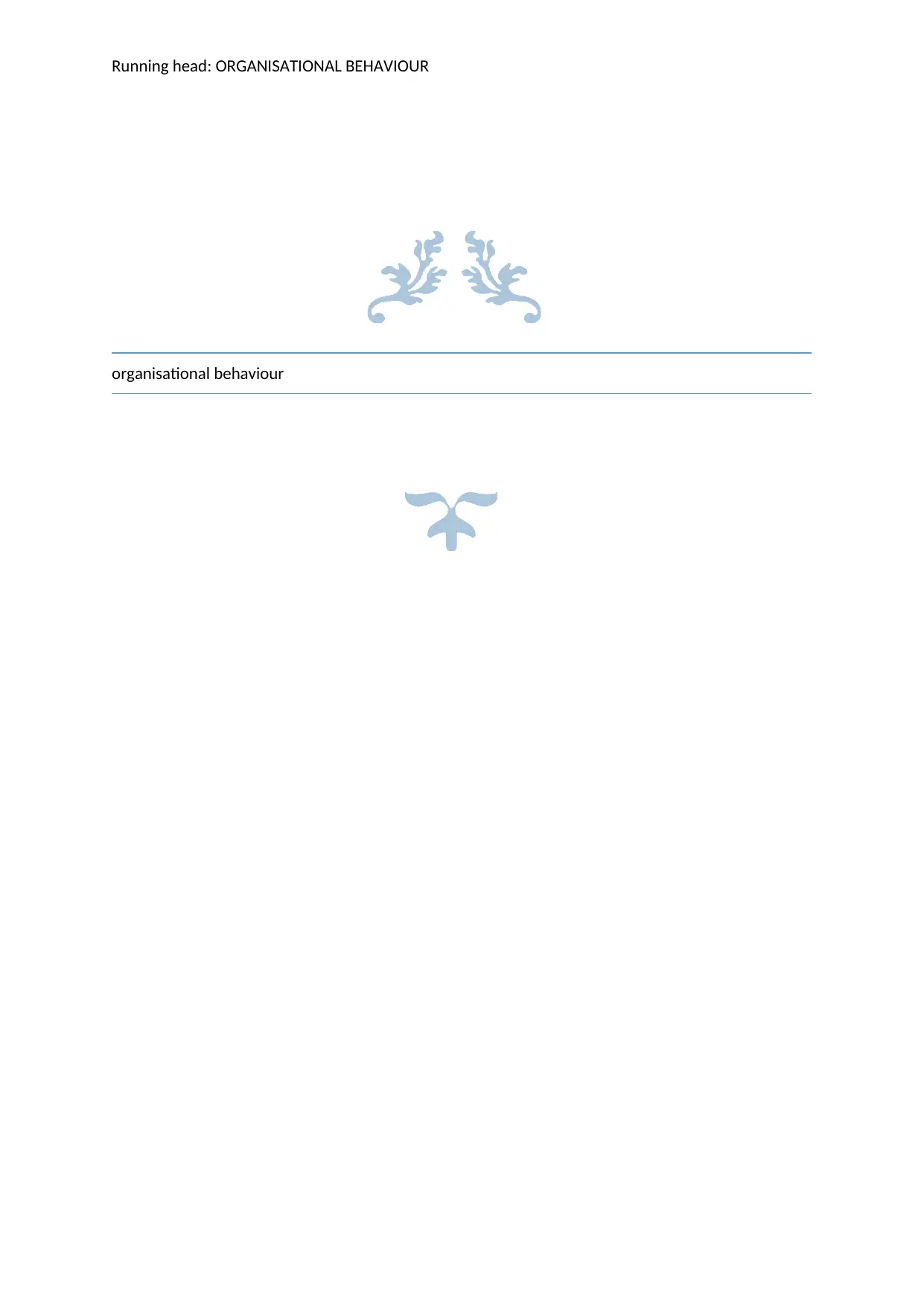
Running head: ORGANISATIONAL BEHAVIOUR
organisational behaviour
organisational behaviour
Paraphrase This Document
Need a fresh take? Get an instant paraphrase of this document with our AI Paraphraser
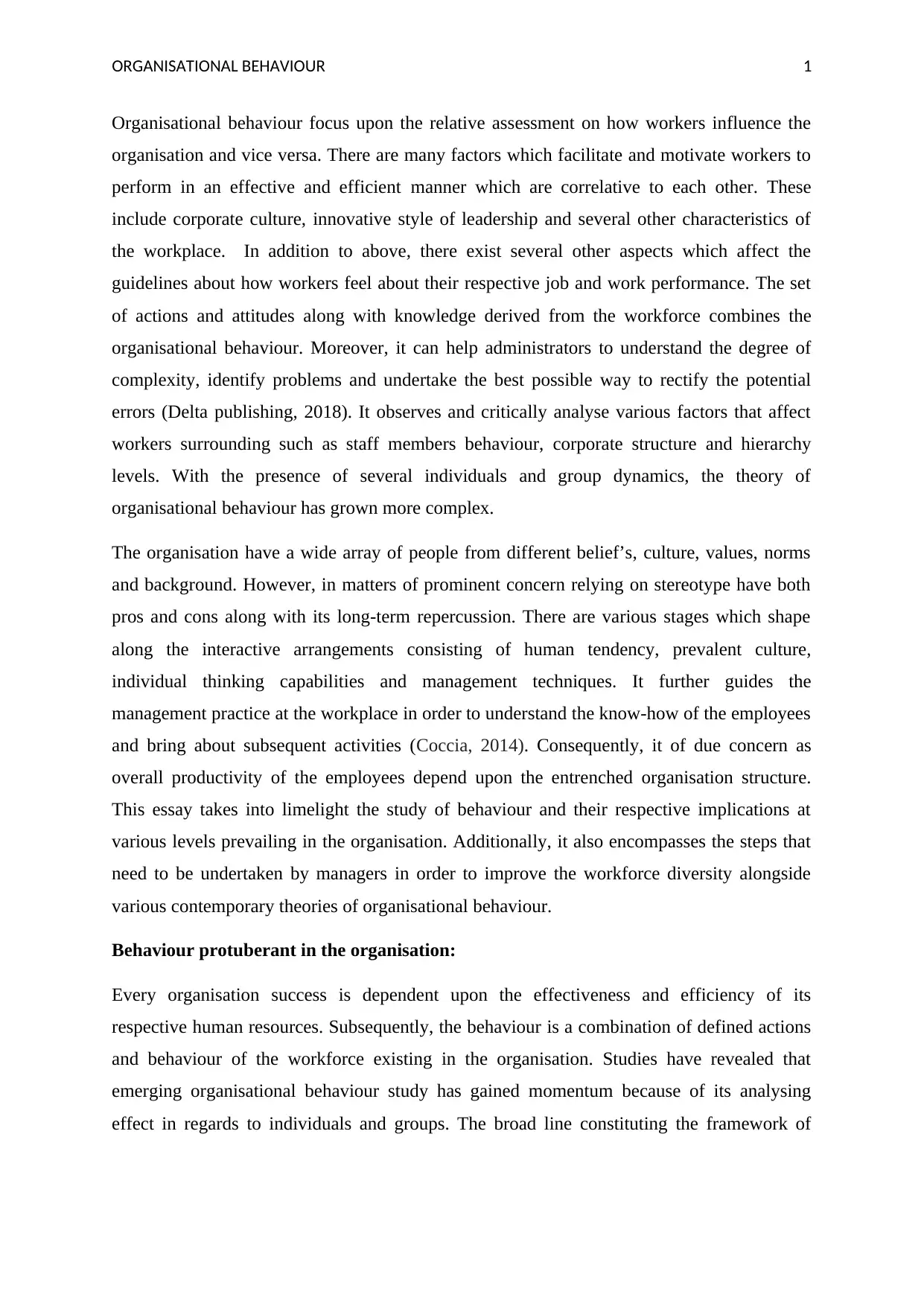
ORGANISATIONAL BEHAVIOUR 1
Organisational behaviour focus upon the relative assessment on how workers influence the
organisation and vice versa. There are many factors which facilitate and motivate workers to
perform in an effective and efficient manner which are correlative to each other. These
include corporate culture, innovative style of leadership and several other characteristics of
the workplace. In addition to above, there exist several other aspects which affect the
guidelines about how workers feel about their respective job and work performance. The set
of actions and attitudes along with knowledge derived from the workforce combines the
organisational behaviour. Moreover, it can help administrators to understand the degree of
complexity, identify problems and undertake the best possible way to rectify the potential
errors (Delta publishing, 2018). It observes and critically analyse various factors that affect
workers surrounding such as staff members behaviour, corporate structure and hierarchy
levels. With the presence of several individuals and group dynamics, the theory of
organisational behaviour has grown more complex.
The organisation have a wide array of people from different belief’s, culture, values, norms
and background. However, in matters of prominent concern relying on stereotype have both
pros and cons along with its long-term repercussion. There are various stages which shape
along the interactive arrangements consisting of human tendency, prevalent culture,
individual thinking capabilities and management techniques. It further guides the
management practice at the workplace in order to understand the know-how of the employees
and bring about subsequent activities (Coccia, 2014). Consequently, it of due concern as
overall productivity of the employees depend upon the entrenched organisation structure.
This essay takes into limelight the study of behaviour and their respective implications at
various levels prevailing in the organisation. Additionally, it also encompasses the steps that
need to be undertaken by managers in order to improve the workforce diversity alongside
various contemporary theories of organisational behaviour.
Behaviour protuberant in the organisation:
Every organisation success is dependent upon the effectiveness and efficiency of its
respective human resources. Subsequently, the behaviour is a combination of defined actions
and behaviour of the workforce existing in the organisation. Studies have revealed that
emerging organisational behaviour study has gained momentum because of its analysing
effect in regards to individuals and groups. The broad line constituting the framework of
Organisational behaviour focus upon the relative assessment on how workers influence the
organisation and vice versa. There are many factors which facilitate and motivate workers to
perform in an effective and efficient manner which are correlative to each other. These
include corporate culture, innovative style of leadership and several other characteristics of
the workplace. In addition to above, there exist several other aspects which affect the
guidelines about how workers feel about their respective job and work performance. The set
of actions and attitudes along with knowledge derived from the workforce combines the
organisational behaviour. Moreover, it can help administrators to understand the degree of
complexity, identify problems and undertake the best possible way to rectify the potential
errors (Delta publishing, 2018). It observes and critically analyse various factors that affect
workers surrounding such as staff members behaviour, corporate structure and hierarchy
levels. With the presence of several individuals and group dynamics, the theory of
organisational behaviour has grown more complex.
The organisation have a wide array of people from different belief’s, culture, values, norms
and background. However, in matters of prominent concern relying on stereotype have both
pros and cons along with its long-term repercussion. There are various stages which shape
along the interactive arrangements consisting of human tendency, prevalent culture,
individual thinking capabilities and management techniques. It further guides the
management practice at the workplace in order to understand the know-how of the employees
and bring about subsequent activities (Coccia, 2014). Consequently, it of due concern as
overall productivity of the employees depend upon the entrenched organisation structure.
This essay takes into limelight the study of behaviour and their respective implications at
various levels prevailing in the organisation. Additionally, it also encompasses the steps that
need to be undertaken by managers in order to improve the workforce diversity alongside
various contemporary theories of organisational behaviour.
Behaviour protuberant in the organisation:
Every organisation success is dependent upon the effectiveness and efficiency of its
respective human resources. Subsequently, the behaviour is a combination of defined actions
and behaviour of the workforce existing in the organisation. Studies have revealed that
emerging organisational behaviour study has gained momentum because of its analysing
effect in regards to individuals and groups. The broad line constituting the framework of
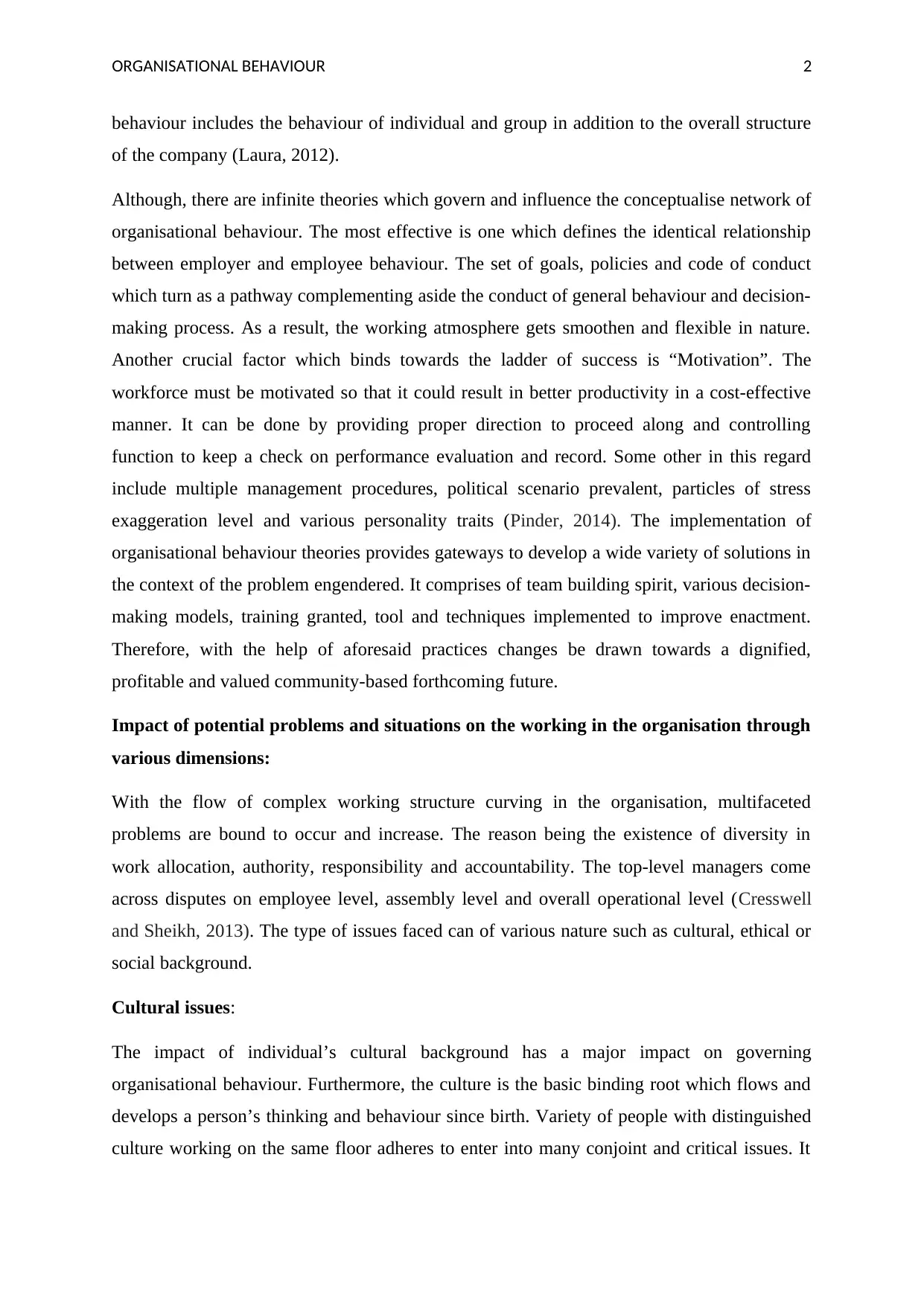
ORGANISATIONAL BEHAVIOUR 2
behaviour includes the behaviour of individual and group in addition to the overall structure
of the company (Laura, 2012).
Although, there are infinite theories which govern and influence the conceptualise network of
organisational behaviour. The most effective is one which defines the identical relationship
between employer and employee behaviour. The set of goals, policies and code of conduct
which turn as a pathway complementing aside the conduct of general behaviour and decision-
making process. As a result, the working atmosphere gets smoothen and flexible in nature.
Another crucial factor which binds towards the ladder of success is “Motivation”. The
workforce must be motivated so that it could result in better productivity in a cost-effective
manner. It can be done by providing proper direction to proceed along and controlling
function to keep a check on performance evaluation and record. Some other in this regard
include multiple management procedures, political scenario prevalent, particles of stress
exaggeration level and various personality traits (Pinder, 2014). The implementation of
organisational behaviour theories provides gateways to develop a wide variety of solutions in
the context of the problem engendered. It comprises of team building spirit, various decision-
making models, training granted, tool and techniques implemented to improve enactment.
Therefore, with the help of aforesaid practices changes be drawn towards a dignified,
profitable and valued community-based forthcoming future.
Impact of potential problems and situations on the working in the organisation through
various dimensions:
With the flow of complex working structure curving in the organisation, multifaceted
problems are bound to occur and increase. The reason being the existence of diversity in
work allocation, authority, responsibility and accountability. The top-level managers come
across disputes on employee level, assembly level and overall operational level (Cresswell
and Sheikh, 2013). The type of issues faced can of various nature such as cultural, ethical or
social background.
Cultural issues:
The impact of individual’s cultural background has a major impact on governing
organisational behaviour. Furthermore, the culture is the basic binding root which flows and
develops a person’s thinking and behaviour since birth. Variety of people with distinguished
culture working on the same floor adheres to enter into many conjoint and critical issues. It
behaviour includes the behaviour of individual and group in addition to the overall structure
of the company (Laura, 2012).
Although, there are infinite theories which govern and influence the conceptualise network of
organisational behaviour. The most effective is one which defines the identical relationship
between employer and employee behaviour. The set of goals, policies and code of conduct
which turn as a pathway complementing aside the conduct of general behaviour and decision-
making process. As a result, the working atmosphere gets smoothen and flexible in nature.
Another crucial factor which binds towards the ladder of success is “Motivation”. The
workforce must be motivated so that it could result in better productivity in a cost-effective
manner. It can be done by providing proper direction to proceed along and controlling
function to keep a check on performance evaluation and record. Some other in this regard
include multiple management procedures, political scenario prevalent, particles of stress
exaggeration level and various personality traits (Pinder, 2014). The implementation of
organisational behaviour theories provides gateways to develop a wide variety of solutions in
the context of the problem engendered. It comprises of team building spirit, various decision-
making models, training granted, tool and techniques implemented to improve enactment.
Therefore, with the help of aforesaid practices changes be drawn towards a dignified,
profitable and valued community-based forthcoming future.
Impact of potential problems and situations on the working in the organisation through
various dimensions:
With the flow of complex working structure curving in the organisation, multifaceted
problems are bound to occur and increase. The reason being the existence of diversity in
work allocation, authority, responsibility and accountability. The top-level managers come
across disputes on employee level, assembly level and overall operational level (Cresswell
and Sheikh, 2013). The type of issues faced can of various nature such as cultural, ethical or
social background.
Cultural issues:
The impact of individual’s cultural background has a major impact on governing
organisational behaviour. Furthermore, the culture is the basic binding root which flows and
develops a person’s thinking and behaviour since birth. Variety of people with distinguished
culture working on the same floor adheres to enter into many conjoint and critical issues. It
⊘ This is a preview!⊘
Do you want full access?
Subscribe today to unlock all pages.

Trusted by 1+ million students worldwide
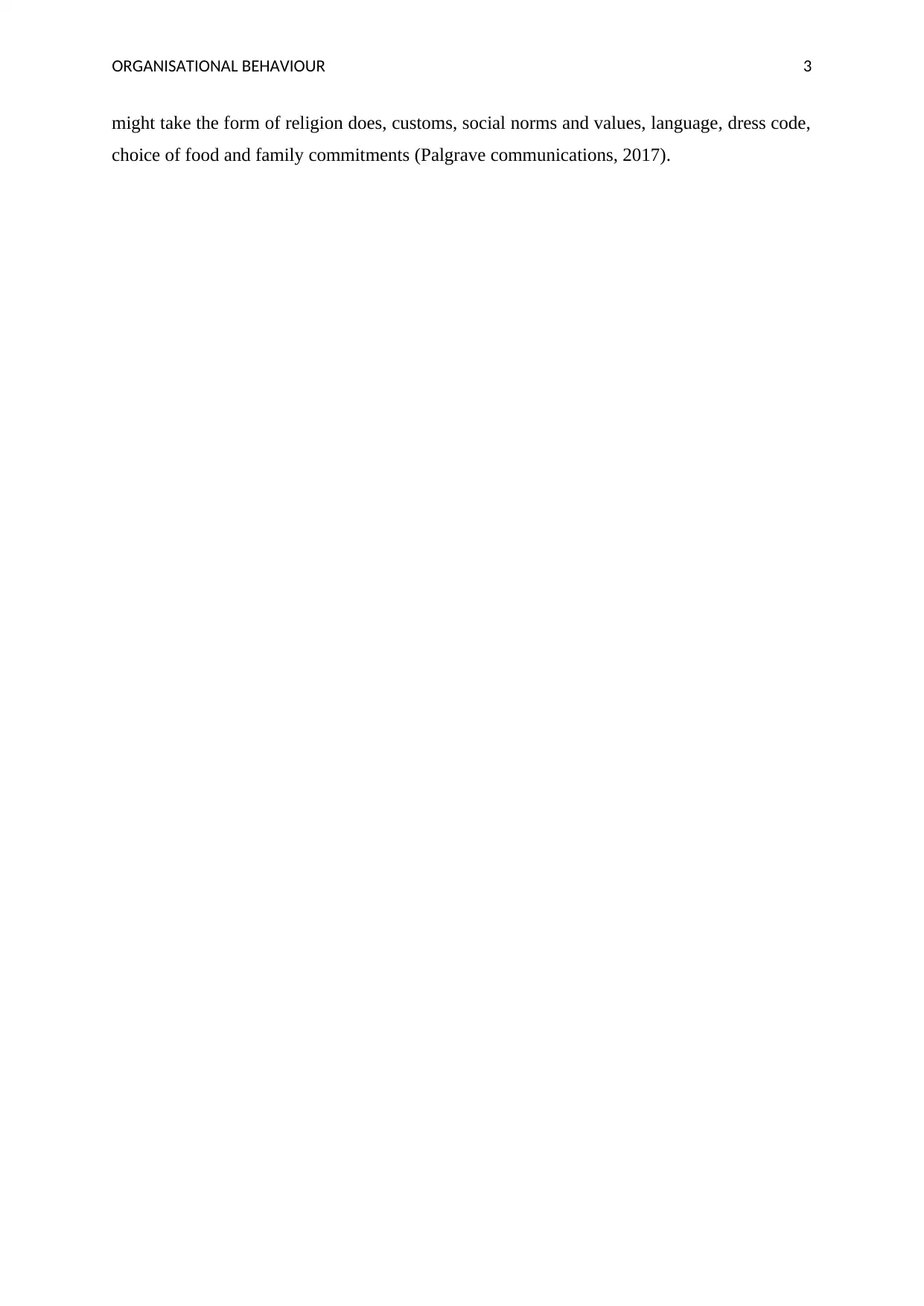
ORGANISATIONAL BEHAVIOUR 3
might take the form of religion does, customs, social norms and values, language, dress code,
choice of food and family commitments (Palgrave communications, 2017).
might take the form of religion does, customs, social norms and values, language, dress code,
choice of food and family commitments (Palgrave communications, 2017).
Paraphrase This Document
Need a fresh take? Get an instant paraphrase of this document with our AI Paraphraser
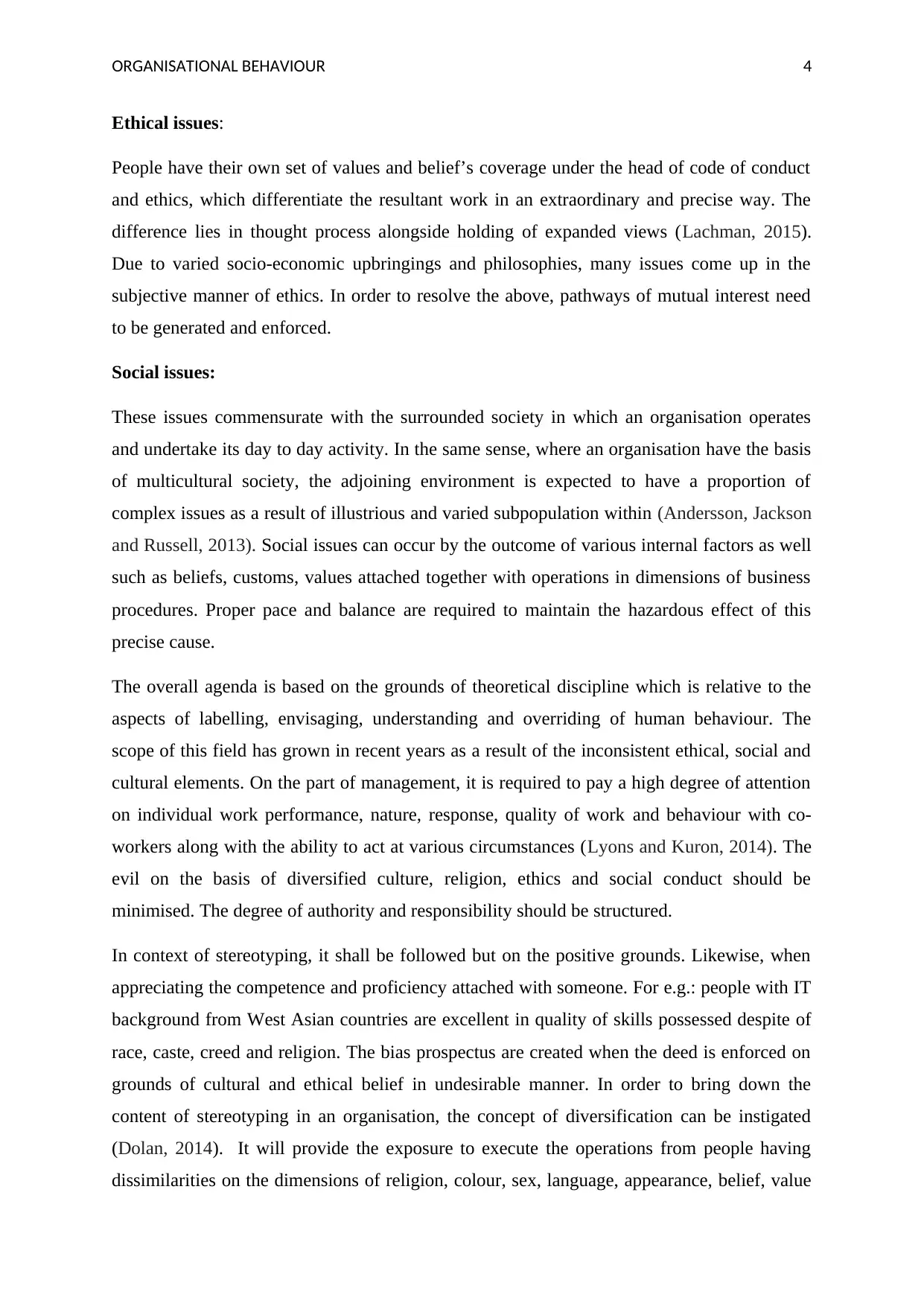
ORGANISATIONAL BEHAVIOUR 4
Ethical issues:
People have their own set of values and belief’s coverage under the head of code of conduct
and ethics, which differentiate the resultant work in an extraordinary and precise way. The
difference lies in thought process alongside holding of expanded views (Lachman, 2015).
Due to varied socio-economic upbringings and philosophies, many issues come up in the
subjective manner of ethics. In order to resolve the above, pathways of mutual interest need
to be generated and enforced.
Social issues:
These issues commensurate with the surrounded society in which an organisation operates
and undertake its day to day activity. In the same sense, where an organisation have the basis
of multicultural society, the adjoining environment is expected to have a proportion of
complex issues as a result of illustrious and varied subpopulation within (Andersson, Jackson
and Russell, 2013). Social issues can occur by the outcome of various internal factors as well
such as beliefs, customs, values attached together with operations in dimensions of business
procedures. Proper pace and balance are required to maintain the hazardous effect of this
precise cause.
The overall agenda is based on the grounds of theoretical discipline which is relative to the
aspects of labelling, envisaging, understanding and overriding of human behaviour. The
scope of this field has grown in recent years as a result of the inconsistent ethical, social and
cultural elements. On the part of management, it is required to pay a high degree of attention
on individual work performance, nature, response, quality of work and behaviour with co-
workers along with the ability to act at various circumstances (Lyons and Kuron, 2014). The
evil on the basis of diversified culture, religion, ethics and social conduct should be
minimised. The degree of authority and responsibility should be structured.
In context of stereotyping, it shall be followed but on the positive grounds. Likewise, when
appreciating the competence and proficiency attached with someone. For e.g.: people with IT
background from West Asian countries are excellent in quality of skills possessed despite of
race, caste, creed and religion. The bias prospectus are created when the deed is enforced on
grounds of cultural and ethical belief in undesirable manner. In order to bring down the
content of stereotyping in an organisation, the concept of diversification can be instigated
(Dolan, 2014). It will provide the exposure to execute the operations from people having
dissimilarities on the dimensions of religion, colour, sex, language, appearance, belief, value
Ethical issues:
People have their own set of values and belief’s coverage under the head of code of conduct
and ethics, which differentiate the resultant work in an extraordinary and precise way. The
difference lies in thought process alongside holding of expanded views (Lachman, 2015).
Due to varied socio-economic upbringings and philosophies, many issues come up in the
subjective manner of ethics. In order to resolve the above, pathways of mutual interest need
to be generated and enforced.
Social issues:
These issues commensurate with the surrounded society in which an organisation operates
and undertake its day to day activity. In the same sense, where an organisation have the basis
of multicultural society, the adjoining environment is expected to have a proportion of
complex issues as a result of illustrious and varied subpopulation within (Andersson, Jackson
and Russell, 2013). Social issues can occur by the outcome of various internal factors as well
such as beliefs, customs, values attached together with operations in dimensions of business
procedures. Proper pace and balance are required to maintain the hazardous effect of this
precise cause.
The overall agenda is based on the grounds of theoretical discipline which is relative to the
aspects of labelling, envisaging, understanding and overriding of human behaviour. The
scope of this field has grown in recent years as a result of the inconsistent ethical, social and
cultural elements. On the part of management, it is required to pay a high degree of attention
on individual work performance, nature, response, quality of work and behaviour with co-
workers along with the ability to act at various circumstances (Lyons and Kuron, 2014). The
evil on the basis of diversified culture, religion, ethics and social conduct should be
minimised. The degree of authority and responsibility should be structured.
In context of stereotyping, it shall be followed but on the positive grounds. Likewise, when
appreciating the competence and proficiency attached with someone. For e.g.: people with IT
background from West Asian countries are excellent in quality of skills possessed despite of
race, caste, creed and religion. The bias prospectus are created when the deed is enforced on
grounds of cultural and ethical belief in undesirable manner. In order to bring down the
content of stereotyping in an organisation, the concept of diversification can be instigated
(Dolan, 2014). It will provide the exposure to execute the operations from people having
dissimilarities on the dimensions of religion, colour, sex, language, appearance, belief, value
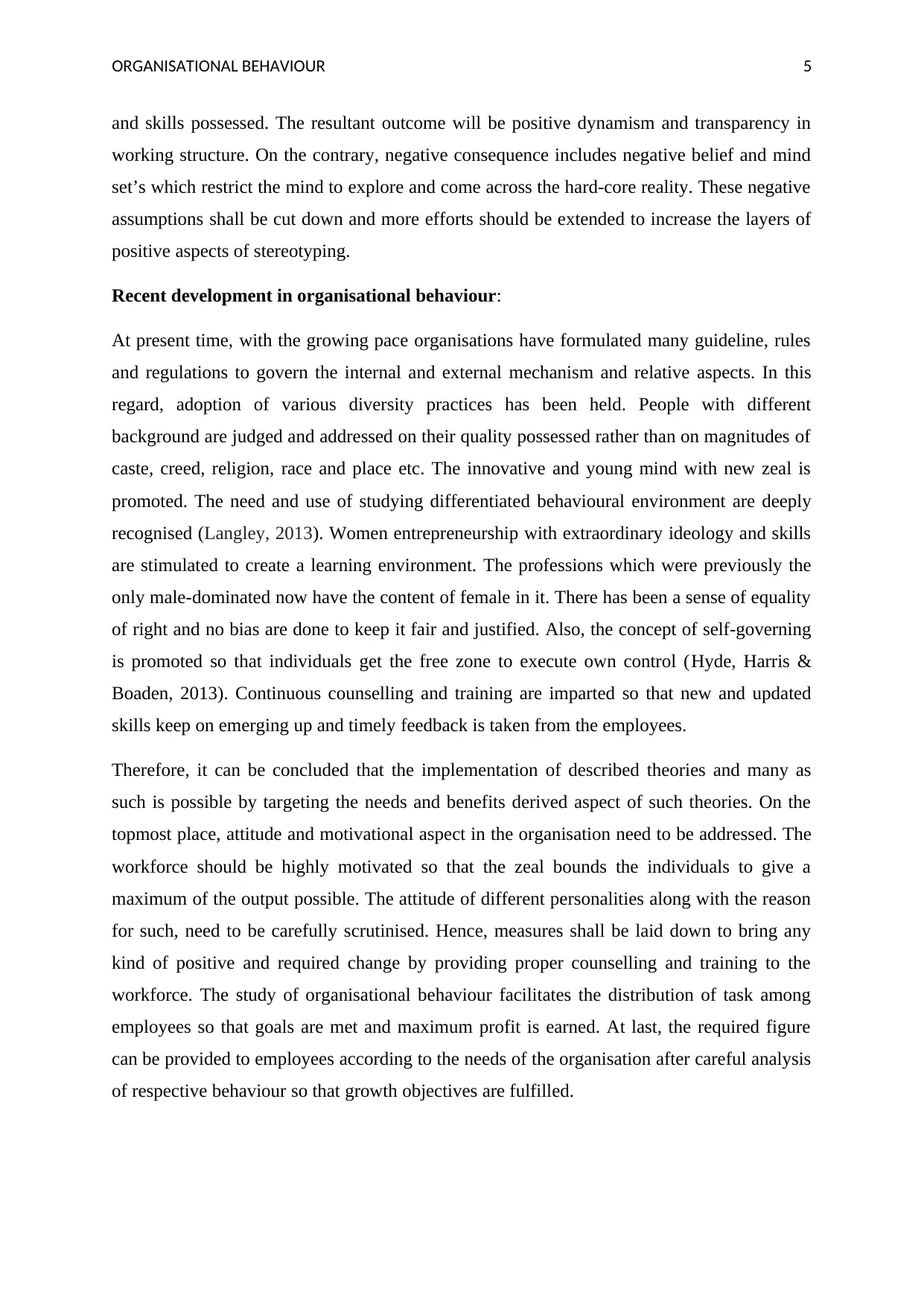
ORGANISATIONAL BEHAVIOUR 5
and skills possessed. The resultant outcome will be positive dynamism and transparency in
working structure. On the contrary, negative consequence includes negative belief and mind
set’s which restrict the mind to explore and come across the hard-core reality. These negative
assumptions shall be cut down and more efforts should be extended to increase the layers of
positive aspects of stereotyping.
Recent development in organisational behaviour:
At present time, with the growing pace organisations have formulated many guideline, rules
and regulations to govern the internal and external mechanism and relative aspects. In this
regard, adoption of various diversity practices has been held. People with different
background are judged and addressed on their quality possessed rather than on magnitudes of
caste, creed, religion, race and place etc. The innovative and young mind with new zeal is
promoted. The need and use of studying differentiated behavioural environment are deeply
recognised (Langley, 2013). Women entrepreneurship with extraordinary ideology and skills
are stimulated to create a learning environment. The professions which were previously the
only male-dominated now have the content of female in it. There has been a sense of equality
of right and no bias are done to keep it fair and justified. Also, the concept of self-governing
is promoted so that individuals get the free zone to execute own control (Hyde, Harris &
Boaden, 2013). Continuous counselling and training are imparted so that new and updated
skills keep on emerging up and timely feedback is taken from the employees.
Therefore, it can be concluded that the implementation of described theories and many as
such is possible by targeting the needs and benefits derived aspect of such theories. On the
topmost place, attitude and motivational aspect in the organisation need to be addressed. The
workforce should be highly motivated so that the zeal bounds the individuals to give a
maximum of the output possible. The attitude of different personalities along with the reason
for such, need to be carefully scrutinised. Hence, measures shall be laid down to bring any
kind of positive and required change by providing proper counselling and training to the
workforce. The study of organisational behaviour facilitates the distribution of task among
employees so that goals are met and maximum profit is earned. At last, the required figure
can be provided to employees according to the needs of the organisation after careful analysis
of respective behaviour so that growth objectives are fulfilled.
and skills possessed. The resultant outcome will be positive dynamism and transparency in
working structure. On the contrary, negative consequence includes negative belief and mind
set’s which restrict the mind to explore and come across the hard-core reality. These negative
assumptions shall be cut down and more efforts should be extended to increase the layers of
positive aspects of stereotyping.
Recent development in organisational behaviour:
At present time, with the growing pace organisations have formulated many guideline, rules
and regulations to govern the internal and external mechanism and relative aspects. In this
regard, adoption of various diversity practices has been held. People with different
background are judged and addressed on their quality possessed rather than on magnitudes of
caste, creed, religion, race and place etc. The innovative and young mind with new zeal is
promoted. The need and use of studying differentiated behavioural environment are deeply
recognised (Langley, 2013). Women entrepreneurship with extraordinary ideology and skills
are stimulated to create a learning environment. The professions which were previously the
only male-dominated now have the content of female in it. There has been a sense of equality
of right and no bias are done to keep it fair and justified. Also, the concept of self-governing
is promoted so that individuals get the free zone to execute own control (Hyde, Harris &
Boaden, 2013). Continuous counselling and training are imparted so that new and updated
skills keep on emerging up and timely feedback is taken from the employees.
Therefore, it can be concluded that the implementation of described theories and many as
such is possible by targeting the needs and benefits derived aspect of such theories. On the
topmost place, attitude and motivational aspect in the organisation need to be addressed. The
workforce should be highly motivated so that the zeal bounds the individuals to give a
maximum of the output possible. The attitude of different personalities along with the reason
for such, need to be carefully scrutinised. Hence, measures shall be laid down to bring any
kind of positive and required change by providing proper counselling and training to the
workforce. The study of organisational behaviour facilitates the distribution of task among
employees so that goals are met and maximum profit is earned. At last, the required figure
can be provided to employees according to the needs of the organisation after careful analysis
of respective behaviour so that growth objectives are fulfilled.
⊘ This is a preview!⊘
Do you want full access?
Subscribe today to unlock all pages.

Trusted by 1+ million students worldwide
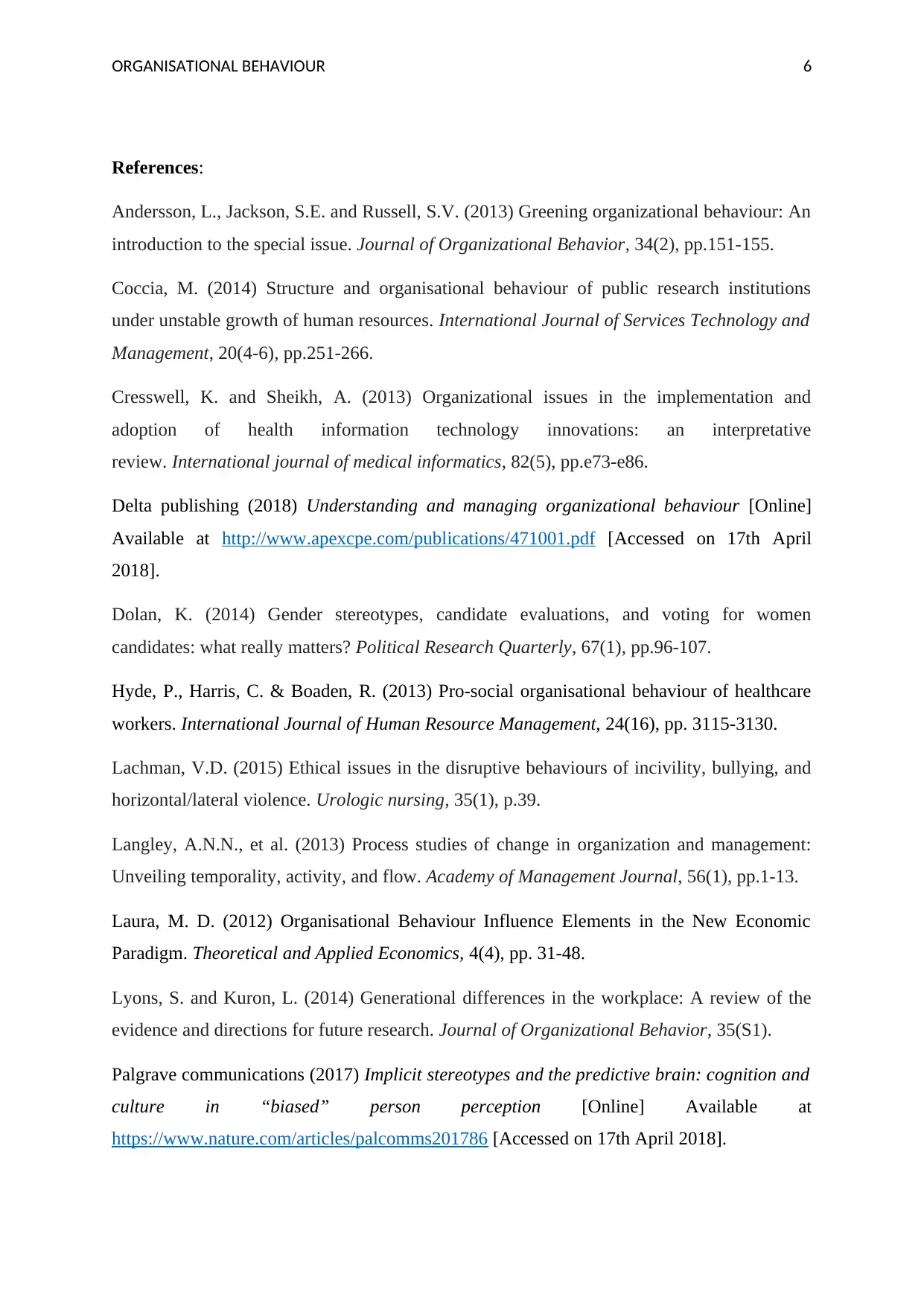
ORGANISATIONAL BEHAVIOUR 6
References:
Andersson, L., Jackson, S.E. and Russell, S.V. (2013) Greening organizational behaviour: An
introduction to the special issue. Journal of Organizational Behavior, 34(2), pp.151-155.
Coccia, M. (2014) Structure and organisational behaviour of public research institutions
under unstable growth of human resources. International Journal of Services Technology and
Management, 20(4-6), pp.251-266.
Cresswell, K. and Sheikh, A. (2013) Organizational issues in the implementation and
adoption of health information technology innovations: an interpretative
review. International journal of medical informatics, 82(5), pp.e73-e86.
Delta publishing (2018) Understanding and managing organizational behaviour [Online]
Available at http://www.apexcpe.com/publications/471001.pdf [Accessed on 17th April
2018].
Dolan, K. (2014) Gender stereotypes, candidate evaluations, and voting for women
candidates: what really matters? Political Research Quarterly, 67(1), pp.96-107.
Hyde, P., Harris, C. & Boaden, R. (2013) Pro-social organisational behaviour of healthcare
workers. International Journal of Human Resource Management, 24(16), pp. 3115-3130.
Lachman, V.D. (2015) Ethical issues in the disruptive behaviours of incivility, bullying, and
horizontal/lateral violence. Urologic nursing, 35(1), p.39.
Langley, A.N.N., et al. (2013) Process studies of change in organization and management:
Unveiling temporality, activity, and flow. Academy of Management Journal, 56(1), pp.1-13.
Laura, M. D. (2012) Organisational Behaviour Influence Elements in the New Economic
Paradigm. Theoretical and Applied Economics, 4(4), pp. 31-48.
Lyons, S. and Kuron, L. (2014) Generational differences in the workplace: A review of the
evidence and directions for future research. Journal of Organizational Behavior, 35(S1).
Palgrave communications (2017) Implicit stereotypes and the predictive brain: cognition and
culture in “biased” person perception [Online] Available at
https://www.nature.com/articles/palcomms201786 [Accessed on 17th April 2018].
References:
Andersson, L., Jackson, S.E. and Russell, S.V. (2013) Greening organizational behaviour: An
introduction to the special issue. Journal of Organizational Behavior, 34(2), pp.151-155.
Coccia, M. (2014) Structure and organisational behaviour of public research institutions
under unstable growth of human resources. International Journal of Services Technology and
Management, 20(4-6), pp.251-266.
Cresswell, K. and Sheikh, A. (2013) Organizational issues in the implementation and
adoption of health information technology innovations: an interpretative
review. International journal of medical informatics, 82(5), pp.e73-e86.
Delta publishing (2018) Understanding and managing organizational behaviour [Online]
Available at http://www.apexcpe.com/publications/471001.pdf [Accessed on 17th April
2018].
Dolan, K. (2014) Gender stereotypes, candidate evaluations, and voting for women
candidates: what really matters? Political Research Quarterly, 67(1), pp.96-107.
Hyde, P., Harris, C. & Boaden, R. (2013) Pro-social organisational behaviour of healthcare
workers. International Journal of Human Resource Management, 24(16), pp. 3115-3130.
Lachman, V.D. (2015) Ethical issues in the disruptive behaviours of incivility, bullying, and
horizontal/lateral violence. Urologic nursing, 35(1), p.39.
Langley, A.N.N., et al. (2013) Process studies of change in organization and management:
Unveiling temporality, activity, and flow. Academy of Management Journal, 56(1), pp.1-13.
Laura, M. D. (2012) Organisational Behaviour Influence Elements in the New Economic
Paradigm. Theoretical and Applied Economics, 4(4), pp. 31-48.
Lyons, S. and Kuron, L. (2014) Generational differences in the workplace: A review of the
evidence and directions for future research. Journal of Organizational Behavior, 35(S1).
Palgrave communications (2017) Implicit stereotypes and the predictive brain: cognition and
culture in “biased” person perception [Online] Available at
https://www.nature.com/articles/palcomms201786 [Accessed on 17th April 2018].
Paraphrase This Document
Need a fresh take? Get an instant paraphrase of this document with our AI Paraphraser
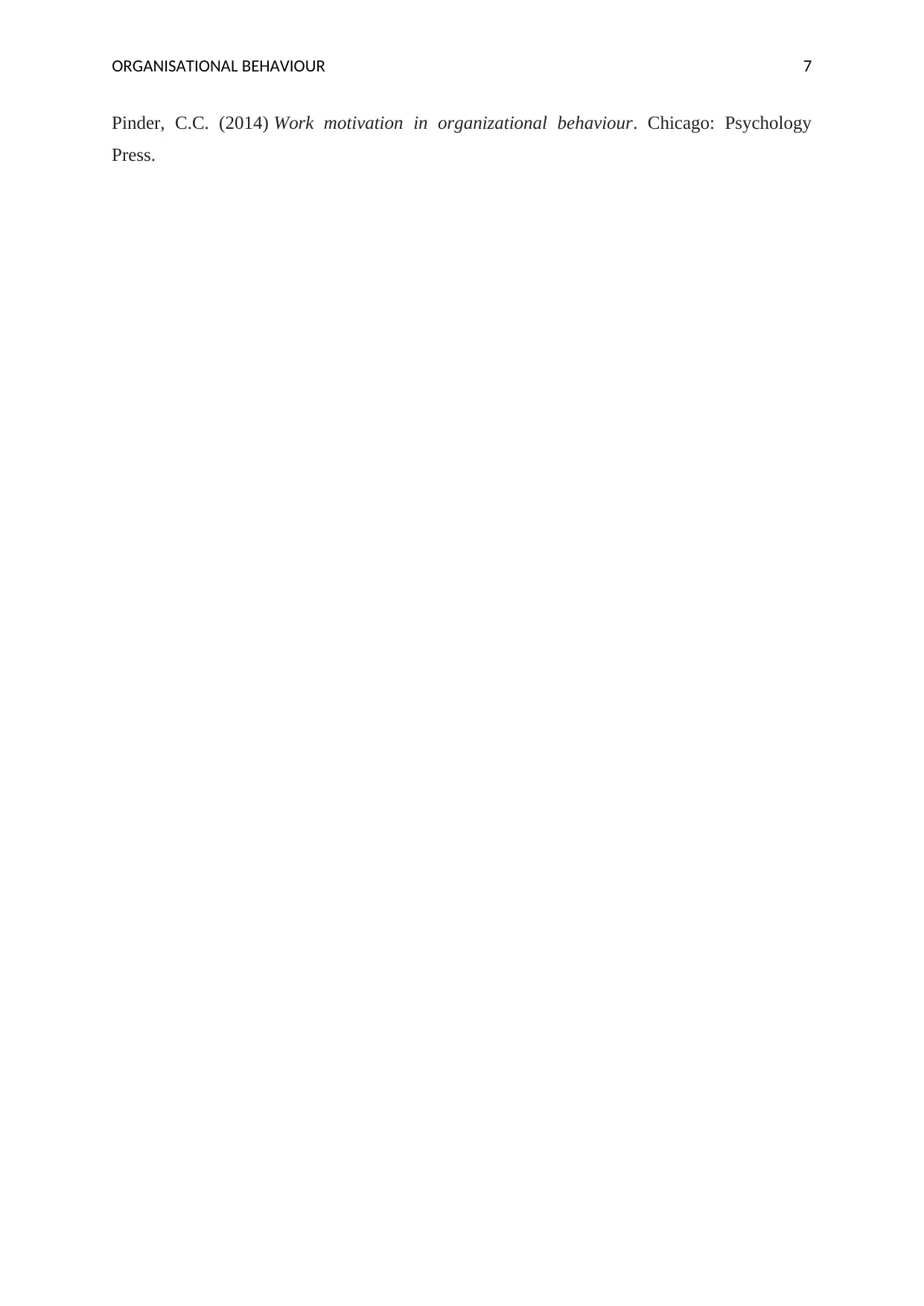
ORGANISATIONAL BEHAVIOUR 7
Pinder, C.C. (2014) Work motivation in organizational behaviour. Chicago: Psychology
Press.
Pinder, C.C. (2014) Work motivation in organizational behaviour. Chicago: Psychology
Press.
1 out of 8
Related Documents
Your All-in-One AI-Powered Toolkit for Academic Success.
+13062052269
info@desklib.com
Available 24*7 on WhatsApp / Email
![[object Object]](/_next/static/media/star-bottom.7253800d.svg)
Unlock your academic potential
Copyright © 2020–2025 A2Z Services. All Rights Reserved. Developed and managed by ZUCOL.





